US Federal Aviation Administration officials have made good on their commitment to expand existing regulations and issue new requirements for charter airlines, commuter airlines, air tour operators and certain aircraft manufacturers to implement safety management systems (SMS).
SMS is a top-down, organization-wide approach to managing safety risk, ensuring that companies have effective risk controls in place that they can act upon. Airlines have been required to have SMS systems in place for several years. And some large airframers, including Boeing, have voluntarily developed their own.
But in 2022, the FAA signaled that proposed rulemaking would seek to plug some clear gaps; and its formal notice dropped in January 2023. Many stakeholders weighed in with comments and suggestions.
Though this process resulted in some material tweaks — with the FAA clarifying, for instance, that the rule applies to type certificate (TC) and production certificate (PC) holders where the United States is “the State of Design or State of Manufacture”, and opting not to expand applicability beyond the original proposal — the agency’s final rule states:
The rule extends the requirement for an SMS to all certificate holders operating under the rules for commuter and on-demand operations, commercial air tour operators, production certificate holders that are holders or licensees of a type certificate for the same product, and holders of a type certificate that license out that type certificate for production.
That includes non-scheduled Part 135 operators, and dozens of smaller design or production certificate holders under Part 21, though some are already in the process of voluntary implementation.
The FAA’s final rule mandates that these organizations develop a SMS within one to three years, depending on the operation. It also requires those who have an SMS to share hazard information with other aviation organizations so they can work collaboratively to identify and address potential safety issues.
“Requiring more aviation organizations to implement a proactive approach to managing safety will prevent accidents and save lives,” FAA Administrator Mike Whitaker says in a statement.
FAA officials clearly took feedback on board, including from the National Business Aviation Association (NBAA), which notes that the rule ensures scalability for the smallest operators, eschews unduly burdensome mandates for single-pilot operations “and provides a more reasonable timeline for implementation of SMS requirements, from 24 to 36 months” for affected members.
The FAA’s work to expand SMS reporting was born out of its review of the Boeing 737 MAX program following two fatal crashes. When the agency ungrounded the MAX on 18 November 2020, it noted in its report that: “The FAA currently requires an SMS only for Part 121 operators. The FAA must mandate implementation of SMS for design and manufacturing organizations, thereby ensuring connection and interrelationship with the existing SMSs of airlines, airports, and service providers.” Its airport SMS rule was issued last year.
The National Transportation Safety Board (NTSB) is lauding the FAA’s latest final rule regarding Part 135 operators and other organizations, with chair Jennifer Homendy saying in a statement: “Requiring more operators to implement proven strategies to protect the flying public is a positive step for safety, and one the NTSB has long supported.
“I applaud FAA for today’s action, which will go a long way toward protecting flight crews and passengers in our skies. We look forward to working with FAA to address even more of our safety recommendations and, together, make our nation’s stellar aviation safety record even better.”
But the NTSB also suggests that the FAA could go further to “protect all passengers”. The board notes it has six open recommendations to the FAA regarding SMS and is currently reviewing the rule to determine which recommendations would be satisfied by it.
The National Air Transportation Association (NATA) is the public policy group that represents the interests of the general aviation business community. “SMS is already an integral part of the aviation safety culture; this action solidifies our members’ dedication to system implementation and advancements,” NATA president and CEO Curt Castagna says in reference to the final rule.
“We are continuing conversations with the agency to address our remaining concerns and develop opportunities to increase the industry’s understanding of the new requirements. We look forward to the release of further FAA guidance that will inform both industry and agency field personnel on process and procedures for effective implementation.”
NATA says it is also working in partnership with its members and the FAA to ensure they have the knowledge and resources to not only comply with the regulation, but also realize the benefits of SMS.
NBAA president and CEO Ed Bolen states: “The business aviation community has always considered safety to be a core value, and has led the way in the voluntary adoption of SMS and other best practices.
“This final rule largely reflects comments from NBAA and hundreds of others who have noted that for an SMS to be effective, it must be tailored to the size and complexity of each operation.”
Related Articles:
- FAA proposed rule mandating SMS for manufacturers nears publication
- US general aviation embarks on important transition to unleaded avgas
- How a Covid cautious prototype led JSX to adopt luxury on its ERJ-145s
- MAX grounding shows aviation must nurture its corporate Cassandras
- Textron looks to realize electric GA and UAM ambitions












